class 8 science ch 1 Notes
CBSE Class 8 Whole Science Notes
We already know that:
- All living organisms require food.
- The energy from food is utilised by an organism for carrying out its various life processes such as digestion, respiration and excretion.
- Plants can make their food themselves but animals including humans cannot.
- We get our food from plants or animals, or both.
In our country three categories of crops are grown:
- Rabi Crops: The crops are grown in the winter season (i.e., from October to March) are called rabi crops. Examples of rabi crops are wheat, gram, pea, mustard, and linseed.
- Zaid Crops (or Summer Crops): The crops grown in the summer season are ( called zaid crops. Moong, muskmelon, watermelon, cucumber, gourd and bitter gourd are examples of zaid crops.
Cultivation of crops involves the following activities:
- Soil Preparation: It involves loosening and tilling of the soil (i.e., ploughing and watering).
- Sowing: Sowing is the process of putting seeds in the soil.
- Adding Manure and Fertilisers: The substances, which are added to the soil in the form of nutrients to improve the production of the crops and fertility of the soil are called manure and fertilisers.
- Irrigation: Supply of water to crops at appropriate intervals is called irrigation.
- Protection from Weeds: Weeds are the unwanted plants that grow along with the crops. Its removal is a must for the better growth of the crops. These can be controlled by spraying certain chemicals, called weedicides, like 2, 4-D.
- Harvesting: The cutting of the crop after it is mature is called harvesting.
- Storage: If the crop grains are to be kept for a longer time, they should be safe from moisture, insects and rats.
Humus: Humus is the top layer of the soil formed by decaying or decomposition of organic matters like animal remains, shed leaves, the dung of cattle.
Pests: Pests are the insects or rodents that destroy’much of our crop yield. Thus, it is necessary to save crops from pests.
Plough: This is used for tilling the soil, adding fertilisers to the crop, removing the weeds, scraping of soil, etc. This implement is made of wood and drawn by a pair of bulls.
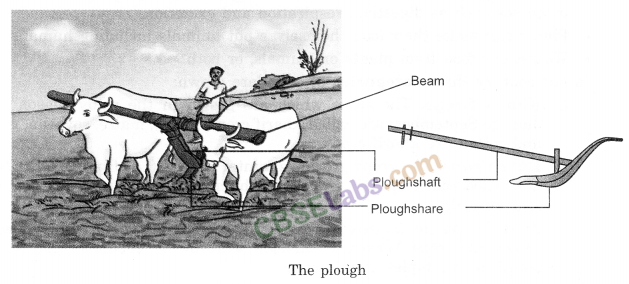
Hoe: It is used for removing weeds and for loosening the soil.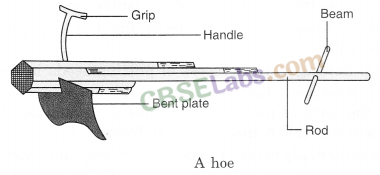
Cultivator: Used for ploughing. It is driven by a tractor. Use of cultivator saves labour and time.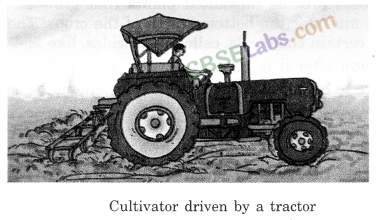
Traditional Tool: The tool used traditionally for sowing seeds is shaped like a funnel.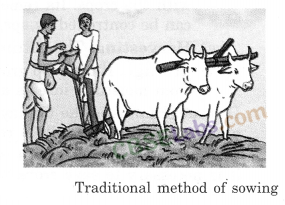
Seed Drill: Used for sowing with the help of tractors. This tool shows the seeds uniformly at a proper distance and depth.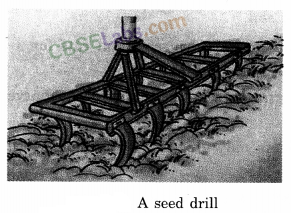
Sickle: Used for manual harvesting.
Food from Animals: Like plants, the animals also provide us with different kinds of food like fish, meat and eggs.
Fumigation: Fumigation is the most effective method for checking the growth of insects by providing smoke or chemicals in the gaseous state without affecting the grain.
Animal husbandry: Animals reared at home or on a farm, have to be provided with proper food, shelter and care, when this is done on a large scale it is called animal husbandry.
Crop: When plants of the same kind are grown at a place in a regular manner on a large scale, it is called a crop.
Fertiliser: Fertilisers are chemicals which are rich in a particular nutrient like nitrogen, phosphorus and potassium.
Granaries: The harvested grains, usually are stored in huge stores, after they are’ properly dried in sunlight. Such stores are called granaries.
Irrigation: Supply of water to crops at appropriate intervals is called irrigation.
Kharif Crops: The crops which are grown in the rainy season, that is from June to September are called kharif crops.
Manure: Manures are decomposed organic matter obtained from plant or animal waste
Plough: The device used for tilling or ploughing is called plough.
Rabi Crops: The crops are grown in the winter season, that is from October to March are called rabi crops.
Seeds: A plant’s fertilised ovules, from which a new plant may grow, are called seeds.
Silo: Harvested grains are usually dried before being stored because moisture encourages the growth of microorganism. They are then stored in metal or earthen container, gunny bags. Such stores are also called silo.
Sowing: It is a process to put seeds in the soil.
Storage: It is to keep crop grains safe from moisture, insects and rats for a long time.
Threshing: The process of separation of grains from the chaff in the harvested plant is called threshing.
Weeds: Some undesirable or unwanted plants may grow naturally along with the crop, such plants are called weeds.
Weedicides: Those certain chemicals which are used to control weeds are called weedicides. For example 2, 4-D (2, 4-dichlorophenoxyacetic acid), metolachlor.
Winnowing: A process to bring out the separation of grain and chaff is called winnowing.


Comments
Post a Comment